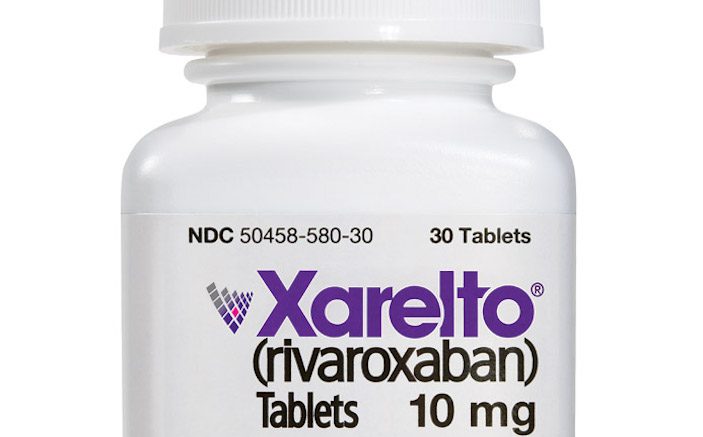Rivaroxaban (sold as Xarelto) has some important advantages over previous vitamin K antagonists.
How It Works
Rivaroxaban, sold under the brand name Xarelto, is a new generation oral anticoagulant. It is a direct factor Xa inhibitor, and produces anticoagulant effects by binding to factor Xa and preventing factor Xa from converting prothrombin to thrombin – the final enzyme of the coagulation cascade that produces fibrin clots [1,2]. Other direct factor Xa inhibitors include apixaban (Eliquis) and edoxaban (Savaysa). Rivaroxaban has some important advantages over older vitamin K antagonists such as warfarin [2]. While vitamin K antagonists inhibit multiple steps in the coagulation cascade, rivaroxaban targets a single clotting factor, Xa, which results in simpler pharmacokinetics. Warfarin levels are affected by diet, medications, and oral intake and require close monitoring, whereas rivaroxaban does not require laboratory monitoring, making it an attractive alternative for patients who are difficult to control on warfarin or who dislike the frequent INR checks. Additionally, rivaroxaban’s anticoagulant effects are immediate, eliminating the need for the heparin bridging required with warfarin. Concern has been raised due to lack of an antidote for rivoraxaban, though activated prothrombin complex concentrate (aPCC) has been shown to reverse the lab findings of anticoagulation in healthy, non-bleeding volunteers [3]. A rivaroxaban-specific antidote is currently in development (see below).
Major Indications
Rivaroxaban is used in the prevention of stroke in patients with nonvalvular atrial fibrillation, the treatment and secondary prevention of deep vein thrombosis and pulmonary embolism, and the prevention of deep venous thrombosis after orthopedic surgery [4,5,6,7].
Notable History
Rivaoraxaban was the first available oral direct factor Xa inhibitor. It was approved by the FDA in 2011.
Recently In The News For
A December 2015 NEJM study reported a potential new antidote for direct factor Xa inhibitors [8]. Andexanet alfa rapidly reversed anticoagulant effects of factor Xa inhibitors rivaroxaban and apixaban in healthy older adult volunteers. Unlike the newly approved idarucizumab (Praxbind), which is a monoclonal antibody against another oral anticoagulant, the direct thrombin inhibitor dabigatran (Pradaxa), andexanet alfa is a decoy protein. It is a recombinant protein that has a similar structure to Xa, and so binds to and sequesters factor Xa inhibitors within the vascular space, restoring endogenous factor Xa activity.
Adverse Events
Bleeding is the most significant complication of rivaroxaban, with non-major bleeding reported in 5-28% of patients [9]. Major bleeding (including intracranial hemorrhage, gastrointestinal hemorrhage, epidural hematoma, retinal hemorrhage) is reported in < 1%. A meta-analysis showed all-cause mortality with direct oral anticoagulants was lower than with warfarin, largely due to a decrease in fatal intracranial bleeding [10].
Cautions
Rivaroxaban should be used with caution in patients at risk for bleeding complications, including congenital or acquired bleeding disorders, stroke, intracerebral surgery, severe uncontrolled hypertension, recent major surgery, recent major bleeding, recent large vessel puncture or organ biopsy, vascular retinopathy, thrombocytopenia, and advanced age. Rivaroxaban may contain lactose, so use is not recommended in patients with lactose or galactose intolerance.
Dosing And Adjustments
Nonvalvular atrial fibrillation: 20 mg PO once daily. For creatinine clearance (CrCl) between 15 to 50 mL/min, dose should be decreased to 15 mg once daily. Deep venous thrombosis (DVT) and pulmonary embolism treatment: 15 mg PO twice daily for 21 days followed by 20 mg PO once daily. For older adults with CrCl between 30 to 50 mL/min, dosage decrease is recommended, but the specific dosage adjustment is not specified.
Postoperative Dvt Prophylaxis
10 mg PO once daily. For older adults with CrCl between 30 to 50 mL/min, dosage decrease is recommended, but the specific dosage adjustment is not specified. Rivaroxaban should be avoided in patients with a CrCl < 30 mL/min.
Special Considerations
Pregnancy category C. Rivaroxaban crosses the placenta, and adverse events were observed in animal reproduction studies, while data is limited on the use of rivoraxaban in human pregnancy. Most experts feel it should not be used in pregnancy. It is not known if rivaroxaban is excreted into breast milk [11]. Use of alternative anticoagulants is recommended in breastfeeding mothers.
Cost
Xarelto starter pack: 15 and 20 mg tablets (51): $679. 10 mg (30 tablets): $399.92. 15 mg (30 tablets): $1199.77
REFERENCES
- J. W. Eikelboom and J. I. Weitz. “New anticoagulants.” Circulation 121.13 (2010): 1523-32. Web.
- D. Garcia, E. Libby, and M. A. Crowther. “The new oral anticoagulants.” Blood 115.1 (2010): 15-20. Web.
- E. S. Eerenberg, et al. “Reversal of rivaroxaban and dabigatran by prothrombin complex concentrate: a randomized, placebo-controlled, crossover study in healthy subjects.” Circulation 124.14 (2011): 1573-9. Web.
- Harry R. Büller, et al. “Oral rivaroxaban for the treatment of symptomatic pulmonary embolism.” New England Journal of Medicine 366.14 (2012): 1287-97. Web.
- EINSTEIN Investigators, et al. “Oral rivaroxaban for symptomatic venous thromboembolism.” The New England journal of medicine 363.26 (2010): 2499-510. Web.
- Ajay K. Kakkar, et al. “Extended duration rivaroxaban versus short-term enoxaparin for the prevention of venous thromboembolism after total hip arthroplasty: a double-blind, randomised controlled trial.” The Lancet 372.9632 (2008): 31-9. Web.
- Manesh R. Patel, et al. “Rivaroxaban versus warfarin in nonvalvular atrial fibrillation.” New England Journal of Medicine 365.10 (2011): 883-91. Web.
- Deborah M. Siegal, et al. “Andexanet alfa for the reversal of factor Xa inhibitor activity.” New England Journal of Medicine 373.25 (2015): 2413-24. Web.
- “Lexicomp Online. Rivaroxaban: Drug information. www.uptodate.com. Accessed April 7, 2016.” Print.
- C. Chai‐Adisaksopha, et al. “Mortality outcomes in patients receiving direct oral anticoagulants: a systematic review and meta‐analysis of randomized controlled trials.” Journal of Thrombosis and Haemostasis 13.11 (2015): 2012-20. Web.
- Gordon H. Guyatt, et al. “Executive summary: antithrombotic therapy and prevention of thrombosis: American College of Chest Physicians evidence-based clinical practice guidelines.” CHEST Journal 141.2_suppl (2012): 7S-47S. Web.



